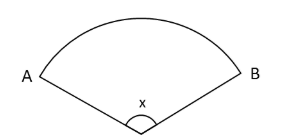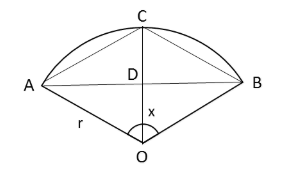[Math Revolution GMAT math practice question]
Attachment:
 11.11.png [ 6.48 KiB | Viewed 1491 times ]
11.11.png [ 6.48 KiB | Viewed 1491 times ]
The above figure shows a sector of a circle. What is the area of the sector?
1) x = 120.
2) AB=6√3.
=>
Forget conventional ways of solving math questions. For DS problems, the VA (Variable Approach) method is the quickest and easiest way to find the answer without actually solving the problem. Remember that equal numbers of variables and independent equations ensure a solution.
Attachment:
 10.15.png [ 9.94 KiB | Viewed 1491 times ]
10.15.png [ 9.94 KiB | Viewed 1491 times ]
The area of a sector is (1/2) πr^2*(x/360), where r is the radius of the sector. Since we have two variables, r and x, C is most likely to be the answer and we need to check both conditions together first.
Conditions 1) and 2):
Quadrilateral OACB is a kite, so its diagonals bisect each other at right angles, and bisect the angles at the vertices.
Since AB = 6√3, AD = AB/2 = 3√3. Since x =120, angle AOD has measure 60, the triangle ODA is a right triangle and OD:OA:DA = 1:2:√3. This yields OA:DA = r: 3√3 = 2: √3, which implies that r = 6.
Thus, the area of the sector is (1/2) π6^2*(120/360) = (1/2) (1/3)36π = 6π.
Both conditions together are sufficient.
Therefore, C is the answer.
Answer: C
Normally, in problems which require 2 equations, such as those in which the original conditions include 2 variables, or 3 variables and 1 equation, or 4 variables and 2 equations, each of conditions 1) and 2) provide an additional equation. In these problems, the two key possibilities are that C is the answer (with probability 70%), and E is the answer (with probability 25%). Thus, there is only a 5% chance that A, B or D is the answer. This occurs in common mistake types 3 and 4. Since C (both conditions together are sufficient) is the most likely answer, we save time by first checking whether conditions 1) and 2) are sufficient, when taken together. Obviously, there may be cases in which the answer is A, B, D or E, but if conditions 1) and 2) are NOT sufficient when taken together, the answer must be E.

